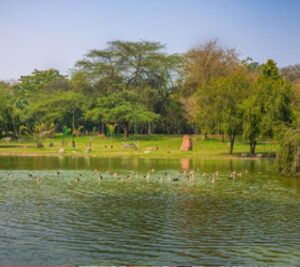Jama Masjid, Delhi
The Jama Masjid Delhi, a monumental marvel of Mughal architecture, stands as one of India’s largest and most magnificent mosques. Situated in the heart of Old Delhi, it is not just a place of worship but also a beacon of cultural and historical significance. This architectural wonder, also known as Masjid-i-Jahan-Numa, which translates to ‘World Reflecting Mosque’, attracts millions of visitors each year, making it a prominent attraction in New Delhi. View below for Jama Masjid History.

Traveller Information
- Location Chawri Bazaar, Delhi, India
- Reach There Metro (Chawri Bazaar Metro Station)
- Entry Fee No Entry Fee, Camera & Video (each 300), Tower 100
- Visiting Time For Non-Muslims (7AM-12PM and 1:30-6:30PM), Minaret (9:00AM-5.30PM)
History of Jama Masjid
The Jama Masjid History dates back to the Mughal era. Commissioned by Emperor Shah Jahan, the same ruler who built the Taj Mahal, the mosque’s construction began in 1650 and was completed in 1656. The mosque’s grandeur reflects the zenith of Mughal architectural prowess and serves as a testament to Shah Jahan’s vision of creating awe-inspiring monuments.
Architectural Brilliance
The Jama Masjid Delhi is an epitome of Mughal architecture, characterized by its grandiose scale and intricate design. The mosque is constructed using red sandstone and white marble, materials that were often used in Mughal architecture for their durability and aesthetic appeal. The central courtyard of the mosque can accommodate up to 25,000 worshippers, making it one of the largest mosques in India.
Minarets and Domes
The mosque features three grand gates, four towers, and two 40-meter-high minarets constructed of strips of red sandstone and white marble. These minarets provide a panoramic view of Old Delhi, allowing visitors to witness the bustling life below from a serene vantage point. The three large domes on the terrace are flanked by two smaller domes, all adorned with black and white marble stripes, adding to the visual appeal of the mosque.
Cultural and Religious Importance
Jama Masjid is not only a historical landmark but also a significant religious site. It remains an active place of worship, hosting daily prayers and special congregations during Islamic festivals such as Eid. The mosque also houses several relics, including an age-old Quran written on deer skin, which holds immense religious importance for the Muslim community.
The Role of Jama Masjid in Mughal Society
During the Mughal era, the Jama Masjid Delhi was more than just a mosque; it was a center of learning and a symbol of the Mughal Empire’s might and sophistication. Scholars from different parts of the Islamic world would gather here to engage in theological discussions and study the Quran, making it a hub of intellectual activity.
Visiting Jama Masjid Delhi
For those planning to visit this architectural gem, there are a few things to keep in mind. The Jama Masjid Delhi is open to visitors of all faiths, but certain etiquettes must be observed. Modest attire is required, and visitors may need to cover their heads as a sign of respect. The mosque remains open from sunrise to sunset, with a break during prayer times.
How to Reach Jama Masjid
Located in the heart of Old Delhi, Jama Masjid is easily accessible by various modes of transport. The nearest metro station is the Chawri Bazaar Metro Station, which is just a short walk away. Alternatively, visitors can hire auto-rickshaws or taxis to reach the mosque. The surrounding area, with its narrow lanes and bustling markets, offers a glimpse into the vibrant life of Old Delhi.
Nearby Attractions
While visiting Jama Masjid, there are several nearby attractions that one should not miss. The iconic Red Fort, another masterpiece of Mughal architecture, is just a stone’s throw away. Additionally, the bustling streets of Chandni Chowk, known for their vibrant bazaars and street food, offer a unique cultural experience.
Conclusion
The Jama Masjid Delhi is not just an architectural masterpiece but also a symbol of India’s rich cultural and religious heritage. Its historical significance, coupled with its stunning architectural features, makes it a must-visit destination for anyone exploring New Delhi. As we delve into the history of Jama Masjid and its role in the Mughal era, we gain a deeper appreciation for this monumental mosque and its enduring legacy.




